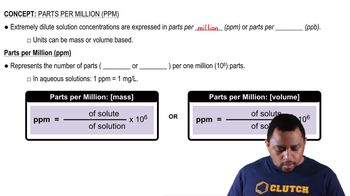Here are the essential concepts you must grasp in order to answer the question correctly.
Molarity
Molarity is a measure of concentration defined as the number of moles of solute per liter of solution. It is expressed in moles per liter (mol/L) and is crucial for comparing the concentration of different solutions. Understanding molarity allows for the calculation of how much solute is present in a given volume of solvent, which is essential for determining which solution is more concentrated.
Recommended video:
Parts per million (ppm) and parts per billion (ppb)
Parts per million (ppm) and parts per billion (ppb) are units used to express very dilute concentrations of substances. 1 ppm is equivalent to 1 mg of solute per liter of solution, while 1 ppb is equivalent to 1 µg of solute per liter. Converting these units to molarity requires knowledge of the molar mass of the solute, which is necessary for comparing the concentrations of the two solutions in the question.
Recommended video:
Conversion between concentration units
To compare the molarity of solutions expressed in different concentration units, it is essential to convert them to a common unit. This involves using the definitions of ppm and ppb to find the mass of solute in a specific volume of solution, and then converting that mass to moles using the molar mass. This process allows for a direct comparison of the concentrations of the two solutions in the question.
Recommended video:
 Verified step by step guidance
Verified step by step guidance


